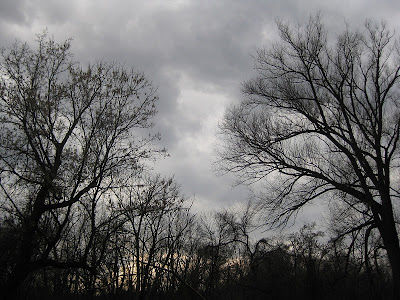Today at Peebles Island, I was drawn to the tree that is on the right in this picture:
I think the reason I was drawn to it was because it had so many little twigs silhouetted against the sky that it looked feathery. The tree drew me, so in order to get closer to it, I climbed down to the riverbank, and walked along the muddy shore of a little side channel. When I was across the channel from the tree, I went to take a picture. When I put the tree in the center of the photo, there was another small tree on the right that did not look right artistically. When I shifted the view toward the left, another tree came into view on the left and made a more balanced composition, so that's the photo I took. I did not look closely at either tree, but based on the brown samaras on the tree on the left, I figured it was a boxelder. I do not know what the tree on the right was.
This photo shows what I consider a stereotypical November day: bare trees and a gray sky.
As I said, I was on the shore of a small side channel off the river. There I could see the remains of a tree. Judging by the girth and the bark, I called it a cottonwood tree. One piece that was mostly still covered with bark lay on the opposite bank. Another piece which had lost most of its bark lay across the channel. They appear to be part of the same tree, but are they really? Why does one piece have bark and the other does not? Could it be that when the water is higher, it washes over the one that goes across, thus washing away the bark? There also seemed to be more moss on the part that had little bark. I don't think that is because moss prefers to grow where there is no bark, because the parts with the most moss were the parts with the most bark. If my theory about the water washing over it is true, maybe the moss prefers the moister environment.
With my camera, I zoomed in on part of the tree across the bank. It kind of reminds me of a dragon.
The barkless branches going across the channel look like strange creatures too. They seem to have antlers.
Behind me, on the same side of the channel where I stood, was this dead snag.
It looks quite magnificent reaching for the sky. What kind of tree is it? How did it die? And how did the cottonwood die? I have been reading in Reading the Forested Landscape about how to deduce the cause of death. I have only read enough to cause me to wonder, not enough to be able to come to any conclusions. Two causes of death mentioned, logging and fire, seem unlikely. More likely causes of death that I've read about are disease and beavers.
The book said that hemlock has the most rot resistant bark, so the bark will remain as the outside rots. So I think this one is not a hemlock. But that is no surprise. The hemlocks on Peebles Island tend not to be this big. The books talk about some trees rotting from the inside out, some from the outside in, and some uniformly throughout. I don't know how rotted this one may be on the inside, but the outside seems to be in pretty good condition, so let's say it rots from the inside out. The book lists oak, locust, and American chestnut as trees which rot from the inside out.
The book says that beavers will fell the trees they eat, but will girdle conifers it does not want to eat in order to make space for trees they prefer to grow up. Was this tree girdled by a beaver?
A close-up view of this snag shows smooth wood with parallel spiral lines.
Although it's not evident in this picture, there were numerous round holes in the trunk. Are they from woodpeckers or insects? I noticed them especially toward the bottom of the trunk.






